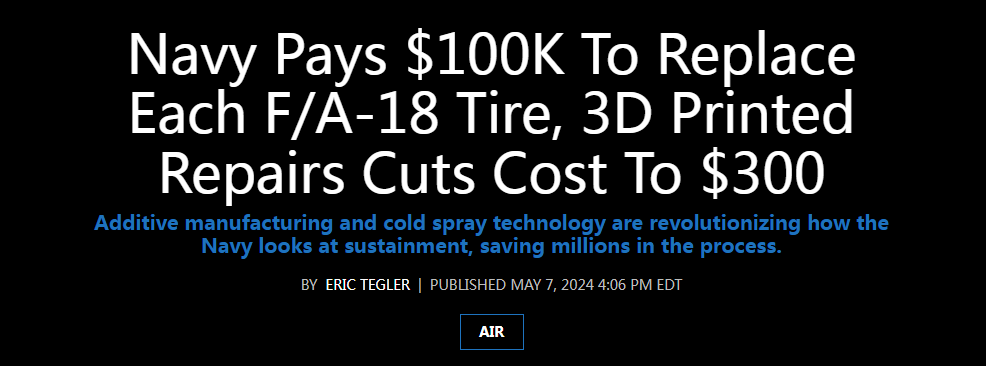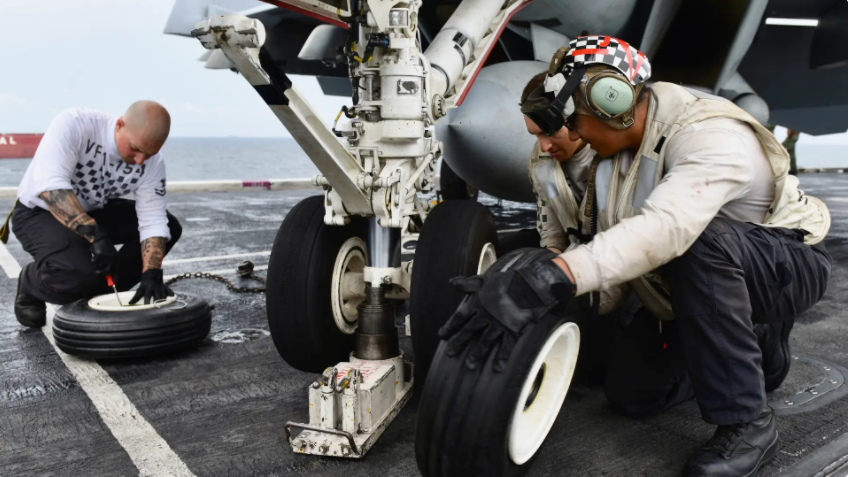
Recently, a U.S. congressman raised a procurement issue regarding a mechanical part costing as much as $90,000, which became a hot topic on social media. Following this, reports of exorbitant procurement costs in the U.S. military have been continuously highlighted by the media and netizens. After the $10,000 toilet seat and the $1,200 coffee cup, the “Power” website discovered another example: aircraft tires priced at $100,000 each.


Ironically, this information came from a report by the U.S. Navy’s public relations department. According to Theodore Gronda, project manager of the additive manufacturing team at the Naval Air Systems Command, replacing the tires of the F/A-18E/F Super Hornet is very expensive. Typically, the Navy replaces the hub along with the outer tire, and according to Gronda, the cost of replacing them is around six figures—specifically, in the $100,000 range.

He explained that when the Super Hornet fighter lands on an aircraft carrier, the main landing gear experiences significant impact, which can easily deform the hub. If such a problem occurs, both the tire and the hub are removed and discarded. Gronda confirmed, “We use 166 of these tire assemblies each year, and their price is in the six-figure range.” Reports suggest that assuming each tire assembly costs $100,000, simple math indicates that the Navy spends as much as $16.6 million annually on replacing these tires.
As for whether this price is reasonable? The “Power” website interviewed suppliers such as Goodyear, Michelin, and Honeywell, but they all refused to provide pricing information…
Regardless, the U.S. Navy has found a cheaper solution—3D printing. Gronda stated that using solid-state cold spray 3D printing technology can repair damaged fighter jet hubs. Simply put, it involves mixing tiny metal particles with nitrogen or helium and spraying them at high speed onto the parts to be repaired, achieving additive repair effects. Gronda confirmed that the team’s “preliminary assessment shows that over 80% of the 166 hubs discarded each year can be repaired using this cold spray 3D printing technology.” He added that each tire’s cold spray repair takes two hours, with an average cost of $300, and the total cost for repairing the hub and reinstalling the tire is expected to be around $40,000 annually.

Thus, the U.S. military’s maintenance costs in this area are expected to drop from $16.6 million annually to $40,000. Even U.S. media have lamented that the series of supply chain issues and inefficient use of funds faced by the military cannot be solved merely by increasing military spending. Utilizing innovative methods like 3D printing to save costs is an approach that the Pentagon should not overlook…
Wait, doesn’t this scenario seem familiar? That’s right, the U.S. Air Force’s $1,200 coffee cup was also resolved using 3D printing technology, reportedly costing only a few dozen dollars; the $10,000 toilet seat was also reduced to $300 using 3D printing…
Goodness, if it weren’t for the publicity from the U.S. military’s 3D printing team, the Pentagon would probably continue to maintain its practice of procuring overpriced parts without a care. This has also been mocked as a distinctly “corrupt” method of the U.S. military—though the term “corruption” is in quotes because these obviously unreasonable procurement projects are theoretically legal and compliant. However, aside from these already exposed projects, how many overpriced parts is the U.S. military still using to funnel huge profits to the military-industrial complex? Perhaps even the Pentagon itself is unclear.

Recently, a U.S. congressman raised a procurement issue regarding a mechanical part costing as much as $90,000, which became a hot topic on social media. Following this, reports of exorbitant procurement costs in the U.S. military have been continuously highlighted by the media and netizens. After the $10,000 toilet seat and the $1,200 coffee cup, the “Power” website discovered another example: aircraft tires priced at $100,000 each.


Ironically, this information came from a report by the U.S. Navy’s public relations department. According to Theodore Gronda, project manager of the additive manufacturing team at the Naval Air Systems Command, replacing the tires of the F/A-18E/F Super Hornet is very expensive. Typically, the Navy replaces the hub along with the outer tire, and according to Gronda, the cost of replacing them is around six figures—specifically, in the $100,000 range.

He explained that when the Super Hornet fighter lands on an aircraft carrier, the main landing gear experiences significant impact, which can easily deform the hub. If such a problem occurs, both the tire and the hub are removed and discarded. Gronda confirmed, “We use 166 of these tire assemblies each year, and their price is in the six-figure range.” Reports suggest that assuming each tire assembly costs $100,000, simple math indicates that the Navy spends as much as $16.6 million annually on replacing these tires.
As for whether this price is reasonable? The “Power” website interviewed suppliers such as Goodyear, Michelin, and Honeywell, but they all refused to provide pricing information…
Regardless, the U.S. Navy has found a cheaper solution—3D printing. Gronda stated that using solid-state cold spray 3D printing technology can repair damaged fighter jet hubs. Simply put, it involves mixing tiny metal particles with nitrogen or helium and spraying them at high speed onto the parts to be repaired, achieving additive repair effects. Gronda confirmed that the team’s “preliminary assessment shows that over 80% of the 166 hubs discarded each year can be repaired using this cold spray 3D printing technology.” He added that each tire’s cold spray repair takes two hours, with an average cost of $300, and the total cost for repairing the hub and reinstalling the tire is expected to be around $40,000 annually.

Thus, the U.S. military’s maintenance costs in this area are expected to drop from $16.6 million annually to $40,000. Even U.S. media have lamented that the series of supply chain issues and inefficient use of funds faced by the military cannot be solved merely by increasing military spending. Utilizing innovative methods like 3D printing to save costs is an approach that the Pentagon should not overlook…
Wait, doesn’t this scenario seem familiar? That’s right, the U.S. Air Force’s $1,200 coffee cup was also resolved using 3D printing technology, reportedly costing only a few dozen dollars; the $10,000 toilet seat was also reduced to $300 using 3D printing…
Goodness, if it weren’t for the publicity from the U.S. military’s 3D printing team, the Pentagon would probably continue to maintain its practice of procuring overpriced parts without a care. This has also been mocked as a distinctly “corrupt” method of the U.S. military—though the term “corruption” is in quotes because these obviously unreasonable procurement projects are theoretically legal and compliant. However, aside from these already exposed projects, how many overpriced parts is the U.S. military still using to funnel huge profits to the military-industrial complex? Perhaps even the Pentagon itself is unclear.
Source: Privy Council No. 10 / Driver Ma Shitu
Editor: Liu Jie
Proofreader: Zhang Xiaoya
Reviewer: Winter Melon Hero
Previous Reviews




Follow Global Network
Stay updated on international news

If you find this interesting, please give it a thumbs up! ↓ ↓